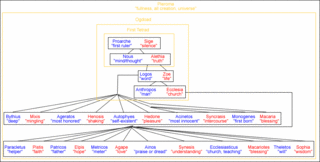The Gnostic Gospels
My church is offering a class on the gnostic gospels on Wednesday nights. This is a continuation of last year's class, which covered Dan Brown's The DaVinci Code. There was such overwhelming interest that the pastor is now offering this class.
Unfortunately, I missed the first session due to some confusion over the church's website calendar. It doesn't look like I missed much, though. We are currently working our way through the first chapter of "Irenaeus: Against Heresies," Book 1, which was written about the followers of Valentinus, a Christian heretic. (See sidebar for link to online copy.)
In the first chapter, Irenaeus sets out the geneology of the pantheon that the Valentinus sect of gnosticism believed in. I'm not really sure if pantheon is the right word, though, because supposedly these spirits aren't really gods, but something beyond gods. The gnostics called them "AEons." Here is a graphical representation of the geneology. Under the Greek/Latin names I put the meaning. Keep in mind that these are all spirits/concepts. Matter has not been created yet at this point in the mythology. The male spirits are in blue, the female in red. Click on the picture for one that is big enough to actually read.

The first tetrad (Proarche, Sige, Nous, and Aletheia) are all equally powerful, even though Nous and Aletheia were created by Proarche and Sige. Also, Nous is the only AEon that is capable of understanding/perceiving Proarche. Confused yet?
All together, there are thirty AEons, called the Pleroma. The gnostics thought that this was the reason why Jesus didn't begin his ministry until he was thirty years old: the thirty years was a way to reveal the nature of the AEons. To quote from Irenaeus, "Such are the thirty Aeons in the erroneous system of these men; and they are described as being wrapped up, so to speak, in silence, and known to none [except these professing teachers]. Moreover, they declare that this invisible and spiritual Pleroma of theirs is tripartite, being divided into an Ogdoad, a Decad, and a Duodecad. And for this reason they affirm it was that the "Saviour"-for they do not please to call Him "Lord"-did no work in public during the space of thirty years, thus setting forth the mystery of these Aeons. They maintain also, that these thirty Aeons are most plainly indicated in the parable of the labourers sent into the vineyard. For some are sent about the first hour, others about the third hour, others about the sixth hour, others about the ninth hour, and others about the eleventh hour. Now, if we add up the numbers of the hours here mentioned, the sum total will be thirty: for one, three, six, nine, and eleven, when added together, form thirty. And by the hours, they hold that the Aeons were pointed out; while they maintain that these are great, and wonderful, and hitherto unspeakable mysteries which it is their special function to develop; and so they proceed when they find anything in the multitude of things contained in the Scriptures which they can adopt and accommodate to their baseless speculations." (Chapter 1, Paragraph 3)
Although Irenaeus is tough going, the things he described are fascinating. This gnostic view is a rich mine for a spec-fic writer, especially since it is not as well known as the Greek or Roman pantheons. I already have a few ideas, although I don't know which stories they will go in.
After we finish Irenaeus, we will be reading as many of the gnostic gospels as we have time for, starting with the Gospel of Thomas.
Unfortunately, I missed the first session due to some confusion over the church's website calendar. It doesn't look like I missed much, though. We are currently working our way through the first chapter of "Irenaeus: Against Heresies," Book 1, which was written about the followers of Valentinus, a Christian heretic. (See sidebar for link to online copy.)
In the first chapter, Irenaeus sets out the geneology of the pantheon that the Valentinus sect of gnosticism believed in. I'm not really sure if pantheon is the right word, though, because supposedly these spirits aren't really gods, but something beyond gods. The gnostics called them "AEons." Here is a graphical representation of the geneology. Under the Greek/Latin names I put the meaning. Keep in mind that these are all spirits/concepts. Matter has not been created yet at this point in the mythology. The male spirits are in blue, the female in red. Click on the picture for one that is big enough to actually read.

The first tetrad (Proarche, Sige, Nous, and Aletheia) are all equally powerful, even though Nous and Aletheia were created by Proarche and Sige. Also, Nous is the only AEon that is capable of understanding/perceiving Proarche. Confused yet?
All together, there are thirty AEons, called the Pleroma. The gnostics thought that this was the reason why Jesus didn't begin his ministry until he was thirty years old: the thirty years was a way to reveal the nature of the AEons. To quote from Irenaeus, "Such are the thirty Aeons in the erroneous system of these men; and they are described as being wrapped up, so to speak, in silence, and known to none [except these professing teachers]. Moreover, they declare that this invisible and spiritual Pleroma of theirs is tripartite, being divided into an Ogdoad, a Decad, and a Duodecad. And for this reason they affirm it was that the "Saviour"-for they do not please to call Him "Lord"-did no work in public during the space of thirty years, thus setting forth the mystery of these Aeons. They maintain also, that these thirty Aeons are most plainly indicated in the parable of the labourers sent into the vineyard. For some are sent about the first hour, others about the third hour, others about the sixth hour, others about the ninth hour, and others about the eleventh hour. Now, if we add up the numbers of the hours here mentioned, the sum total will be thirty: for one, three, six, nine, and eleven, when added together, form thirty. And by the hours, they hold that the Aeons were pointed out; while they maintain that these are great, and wonderful, and hitherto unspeakable mysteries which it is their special function to develop; and so they proceed when they find anything in the multitude of things contained in the Scriptures which they can adopt and accommodate to their baseless speculations." (Chapter 1, Paragraph 3)
Although Irenaeus is tough going, the things he described are fascinating. This gnostic view is a rich mine for a spec-fic writer, especially since it is not as well known as the Greek or Roman pantheons. I already have a few ideas, although I don't know which stories they will go in.
After we finish Irenaeus, we will be reading as many of the gnostic gospels as we have time for, starting with the Gospel of Thomas.


2 Comments:
Another lurker here!
This is very interesting stuff. Thanks for posting. I hardly know anything about the Gnostics. I guess I've just sort of shied away from it.
Is it true that the New Age is a sort of extension of Gnostisicm?
We discussed that a bit in class! New Age existed before the gnostic gospels were found at Nag Hammadi, but they do have some things in common. Both New Agers and the Gnostics were heavily influenced by eastern religion and philosophy, and both groups try to make a coherent story by combining eastern and western thought. After the gnostic gospels were released, the New Age movement essentially adopted them as something like their own Bible.
It is interesting, because the picture of Gnosticism that Irenaeus paints is very hostile to women. We just read the part where the entire physical universe is created from Sophia (a female AEon)'s "ignorance and grief, and fear and bewilderment" (Ir Ch.2 P.3) after she tried in vain to see Proarche. I wonder if this will come through as strongly in the actual gnostic gospels, and if so, how the New Agers justify it.
Well, I've rambled on long enough. It is a fascinating topic, and I've only learned a tiny bit of it so far.
Post a Comment
<< Home